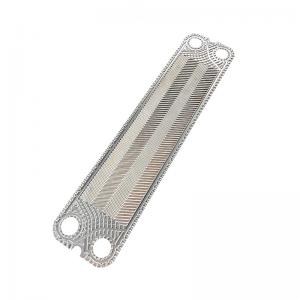Product Details
Product Description
High-Performance Titanium Alloy GEA Heat Exchanger Plates 0.5mm
0.6mm Thickness
GEA Heat Exchanger Plates
- Plate heat exchanger plates serve a crucial function in plate heat
exchangers by facilitating efficient heat transfer while
effectively isolating different fluid streams. These plates are
meticulously engineered using advanced CAD/CAM technology and
undergo a precise pressing process, ensuring exceptional precision
and thinness. Consequently, the thinner plates contribute to
enhanced heat transfer efficiency.
- The plate heat exchanger plates are designed to be compatible with
renowned brands such as Alfalaval, ACCESSEN, GEA (Kelvion), APV,
Sondex, Tranter, Hisaka, API, Funke, Vicarb, Mueller, SWEP,
Fischer, AGC, Thermalwave, ITT, LHE, DHP, and others. This broad
compatibility enables their application in various industries,
including HVAC, chemical processing, power generation, and food and
beverage.
- With their reliable thermal performance, durability, and
compatibility, these plates are widely trusted for efficient heat
exchange in diverse industrial settings. Whether it's optimizing
energy usage, maintaining process temperatures, or ensuring product
quality, plate heat exchanger plates play a vital role in
delivering effective heat transfer solutions.
| Brand | Model |
GEA | VT04,VT10,VT20,VT40,VT80,VT405,VT2508,N40,FA184,NT50, NT100T,NT100MNT100X,NT150S,NT150L,NT250S,NT250M, NT250L,NT350S, NT350M,NT500 |
| Material | Specification |
| Stainless Steel | SUS304 316 316L 310S 904 |
| Titanium and titanium-palladium alloy | TAi TAi-Pd |
| Hastelloy | C276 D205 B2G |
| Nickel | Ni200 Ni201 |
| Molybdenum | 254 |
Applacations
| Plate material | Suitable for fluids |
| Stainless steel (SUS304.316, etc.) | Purified water, river water, edible oil, mineral oil |
| Titanium and titanium palladium (Ti, Ti-Pd) | Sea water, salt water, salt compounds |
| 20Cr,18Ni,6Mo(254SMO) | Dilute sulfuric acid, dilute salt aqueous solution, inorganic
aqueous solution |
| Nickel (Ni) | High temperature, high concentration caustic soda |
| HASTELLOY alloy (C276, D205, B2G) | Concentrated sulfuric acid, hydrochloric acid, phosphoric acid |
Plate heat exchanger plate thickness configuration
- AISI 304 is usually 0.4 or 0.5 mm thickness
- AISI 316 is always 0.5 and 0.6 mm
- 254 SMO (high alloy) typically 0.6 mm
- Titanium plates are always 0.5 and 0.6 mm
- Some have thicker plates (for high pressure applications)
- Some PHEs have 0.4 mm (low pressure operation)
- Hastelloy C-276 (nickel alloy) typically 0.6 mm
Production Process:
The production of stainless steel plates for plate heat exchangers
involves several precise steps to ensure high-quality performance
and longevity.
- Cutting and Leveling: Stainless steel plates are accurately cut
using advanced machine tools to meet the specific design
requirements. After cutting, a leveling treatment is applied to
ensure a smooth and even surface. This step is crucial for
maintaining efficient heat transfer capabilities.
- Stamping: The flattened plates undergo a meticulous stamping
process using hydraulic presses. This process creates unique
herringbone patterns on the plates, which significantly increase
turbulence inside the heat exchanger. The controlled turbulence
promotes optimal heat transfer by maximizing fluid contact with the
plate surfaces. Special attention is given to maintaining precise
control during stamping to prevent plate deformation or damage.
- Surface Treatment: To enhance corrosion resistance and optimize
heat transfer performance, the plates undergo surface treatments
such as polishing, sandblasting, or coating. The specific treatment
method is selected based on the desired requirements and operating
conditions. These treatments improve the plates' resistance to
corrosion, fouling, and scaling, ensuring long-term efficiency and
reliability.
Company Profile
Jiangsu Victory Co., Ltd. is a professional manufacturer of plate
heat exchangers (PHE), heat exchanger gaskets (PHE GASKET), and
heat exchanger plates (PHE PLATE).
Our company has introduced advanced design and production
technology as well as advanced heat exchanger expertise at home and
abroad, and has been committed to serving the HVAC, refrigeration,
energy and power, metallurgy, chemical industry, pharmaceutical,
food, electronics, shipbuilding and environmental treatment
markets. , providing on-demand heat exchange solutions and
all-round services. Friends are welcome to visit, guide and
negotiate business.
At the same time, we are also a professional supplier and
maintainer in the field of plate heat exchanger accessories (heat
exchanger plates and heat exchanger gaskets). Able to provide the
same products as many well-known brands at home and abroad
(including: Alfa, ACCESSEN, GEA, TRANTER, SONDEX, FUNKE, Vicarb,
etc.) Plate heat exchanger plates and gaskets in specified sizes.
No matter where you are, no matter what your special requirements
are, Victory is willing to provide you with system solutions in the
field of plate heat exchangers.




